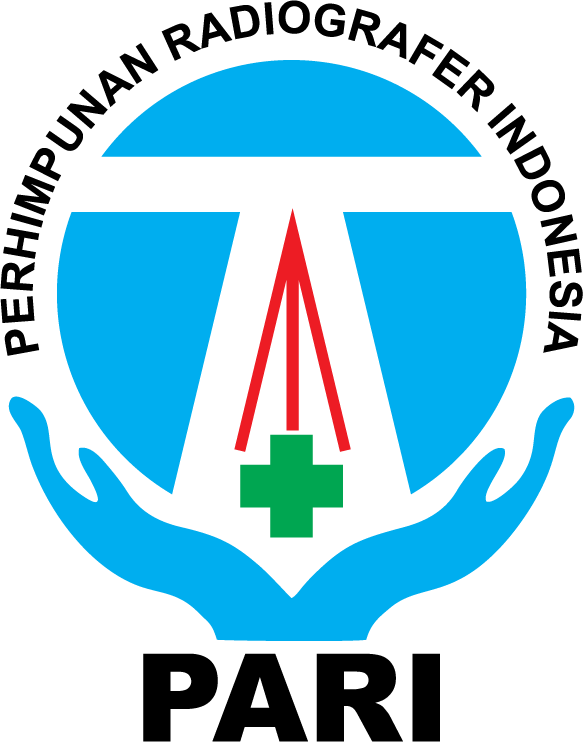Penggunaan T2 STIR dan Fat Saturation pada Pemeriksaan MRI Lumbal Kasus Hernia Nucleus Pulposus (HNP)
Abstract
Background: Signal to noise ratio (SNR) is defined as the ratio of the amplitude of the signal received by the coil to the amplitude of the noise.
Methods: This research was quantitative alongside an observational approach conducted at the Radiology Installation of Satya Negara Hospital, North Jakarta. Alongside a research population of Lumbar MRI patients with HNP clinical indication from October to November 2022. The research sample was ten patients aged around 25-50 years with a diagnosis of HNP. Furthermore, an MRI examination was carried out using T2 STIR and T2 Fat Saturation sequences. Hence, the results of the Lumbar MRI image were ROI performed on common areas alongside the Corpus, Discus, CSF, Spinal Cord, and HNP area.
Results: This research showed there was a significant difference in SNR values in the T2 STIR and T2 Fat Saturation sequences in common areas with a p-value of > 0.05. There was no significant difference in SNR values in the HNP-experienced area with a p-value of < 0.05.
Conclusions: After a statistical test using the Paired Sample T Test, the test results obtained were p value > 0.05, namely 0.692 for the SNR value on the results of the MRI Lumbar sagittal section of the sequence T2 STIR and T2 Fat saturation in the Lumbar area experiencing HNP, which means that Ho was accepted, which means that there was no significant difference in SNR values between the T2 STIR and T2 Fat saturation sequences in the lumbar tissue that experienced HNP. 2. The SNR value of MRI images of the lumbar sagittal section of the sequence T2 STIR and T2 Fat saturation in normal lumbar tissue including Corpus, Discus, CSF, the test results obtained are p-value <0.05. This means that Ho was rejected, which means there was a significant difference in SNR values between the T2 STIR and T2 Fat saturation sequences. In the spinal cord area, the test results obtained were p value > 0.05. This meant that Ho was accepted, which meant there was no significant difference in SNR values between the T2 STIR and T2 Fat saturation sequences.
Keywords
Full Text:
PDFReferences
Astari, F. M. (2018). Perbedaan Informasi Citra Diagnostik Antara Sekuen T2 TSE STIR Dan T2 TSE Dixon Pada Pemeriksaan MRI Lumbal Potongan Sagital Dengan Kasus Radiculopathy. JRI (Jurnal Radiografer Indonesia), 1(1), 52-60. Guerini, H., Omoumi, P., Guichoux, F.,
Vuillemin, V., Morvan, G., Zins, M., Thevenin, F., & Drape, J. L. (2015). Fat Suppression With Dixon Techniques In Musculoskeletal Magnetic Resonance Imaging: A Pictorial Review. Seminars In Musculoskeletal Radiology, 19(4), 335–347. Https://Doi.Org/10.1055/S-0035-1565913
YB, M. B., Darmini, D., & Mulyati, S. (2020). ANALISIS PERBEDAAN KUALITAS CITRA DAN INFORMASI ANATOMI PADA PEMERIKSAAN MRI LUMBAL SEKUEN T2WI FAST SPIN ECHO (FSE) POTONGAN SAGITAL DENGAN VARIASI NILAI TIME REPETITION. JRI (Jurnal Radiografer Indonesia), 3(1), 5-12.
Rochmayanti, D., Widodo, T. S., & Soesanti, I. (2013). Analisis Perubahan Parameter Number Of Signals Averaged ( NSA ) Terhadap Peningkatan SNR Dan Waktu Pencitraan Pada MRI. Jnteti, 2(4), 37–45.
Varlotta, C. G., Ge, D. H., Stekas, N., Frangella, N. J., Manning, J. H., Steinmetz, L., ... & Buckland, A. J. (2020). MRI radiological predictors of requiring microscopic lumbar discectomy after lumbar disc herniation. Global Spine Journal, 10(1), 63-68.
Zaky, A., Novita Andriani, A., & Awal Bros Pekanbaru, Stik. (2020). Journal Of Stikes Awal Bros Pekanbaru. Ojs.Stikesawalbrospekanbaru.Ac.Id, 2014, 41–47. Http://Ojs.Stikesawalbrospekanbaru.Ac.Id/Index.Php/Jsabp/Article/View/33
Brandão, S., Seixas, D., Ayres-Basto, M., Castro, S., Neto, J., Martins, C., ... & Parada, F. (2013). Comparing T1-weighted and T2-weighted three-point Dixon technique with conventional T1-weighted fat-saturation and short-tau inversion recovery (STIR) techniques for the study of the lumbar spine in a short-bore MRI machine. Clinical radiology, 68(11), e617-e623.
Ren, A. J., Guo, Y., Tian, S. P., Shi, L. J., & Huang, M. H. (2012). MR imaging of the spine at 3.0 T with T2-weighted IDEAL fast recovery fast spin-echo technique. Korean Journal of Radiology, 13(1), 44-52.
DOI: https://doi.org/10.31983/jimed.v9i1.9456
Article Metrics
Refbacks
- There are currently no refbacks.
JURNAL IMEJING DIAGNOSTIK by http://ejournal.poltekkes-smg.ac.id/ojs/index.php/jimed is licensed under a Creative Commons Attribution-ShareAlike 4.0 International License.

.png)
.png)
.png)
.png)
.png)
.png)
.png)











